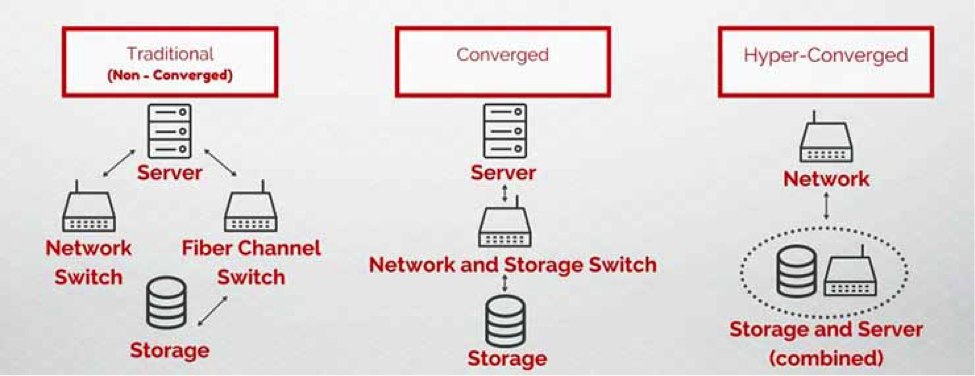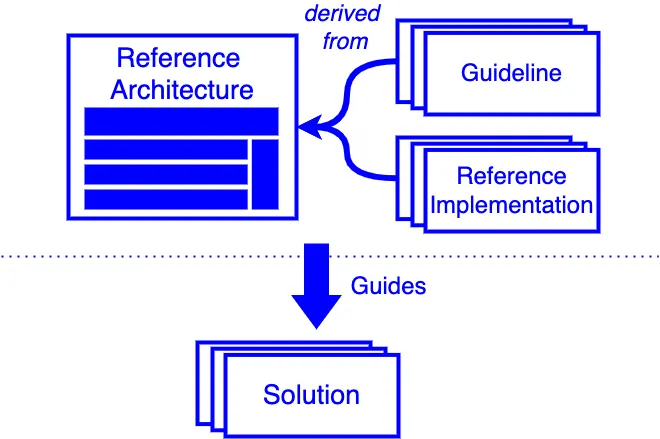Time is the greatest enemy of IT.
Developers need better agility to use their time more effectively rather than stitching infrastructures together. Convergence makes this possible by bringing in compute, storage, and networking together in an infrastructure.
Converged infrastructure (CI) allows organizations to maximize their speed to value while creating virtual machines (VMs). It improves resource deployment speed and makes it more scalable in delivering consistent performance. With the help of solutions validated by a vendor, you have to do less guesswork, reducing any deployment risk.
Many businesses use hyperconverged infrastructure solutions (advanced alternatives to CI) to virtualize their servers (compute), storage, and networks. These solutions take a software-centric approach, where each element is integrated and managed as a system.
Let’s explore converged infrastructure and understand why IT moved from traditionally setting up virtual machines to a hyperconverged software-defined route.
What is converged infrastructure?
Converged infrastructure (CI) bundles together storage, server, networking, and virtualization while setting up a VM. Earlier, these components were stitched manually into a data center infrastructure. With CI, businesses save time setting up or configuring each hardware piece as it comes pre-configured by the vendor.
The package synchronizes hardware and software so users can manage all their resources through one system. This allows them to avoid headaches associated with compatibility checks or manual setups.
Although CI architecture is similar to non-converged infrastructure, the converged architecture comes pre-integrated from the vendor. Non-converged infrastructure consists of hardware components that clients purchase individually and then integrate themselves or with the help of hired consultants.
Development of converged infrastructure
IT resources were deployed in silos earlier. They were dedicated to a technology or business line, managing one demand type. As usage needs kept changing, the setup wasn’t fit to make reliable optimizations or corrections. This led to IT sprawl, hampering productivity and operating costs.
This cost increase lowered the IT budget for driving new initiatives, making it trickier for IT to adapt to real application demand. When developed, converged infrastructure tackled this issue by creating a shared pool of virtualized servers and networks across different business areas and applications.
¿Quieres aprender más sobre Soluciones de Infraestructura Hiperconvergente (HCI)? Explora los productos de Soluciones de Infraestructura Hiperconvergente (HCI).
Types of infrastructure technologies
Below are a few common types of infrastructure technologies. This section will help you evaluate these technologies better.
Traditional
(Compute, storage, and network components are physically distinct and managed separately.)
In this type, sometimes the storage resides within the servers themselves, but it's still considered traditional because it’s not managed centrally. You get to pick the vendor of your choice for each tier.
Did you know? In cloud computing, “compute” describes concepts and objects related to software computation.
Customers who wish to change server vendors can do so without any other disruption to their environment. Each tier is independently scalable. You can add capacity to a storage array or server to compute stacks without affecting other systems.
What to look out for?
It takes up more physical space and is expensive. You might feel that repurposing components for other workloads is cumbersome.
Virtual
(One or more of the components have been abstracted by software from their physical components.)
The most common virtual deployments are in the compute stack, with storage and server gaining traction.
Virtualization mitigates the amount of hardware you need to deploy. It increases operational efficiency using centralized management and allows you to use more of your deployed capacity.
What to look out for?
It adds to the cost and overhead of virtualization technology.
Converged
(Compute, network, and storage are still physically discrete components, but they're all managed from one point.)
In a converged infrastructure, compute, storage, and networking are all controlled via a single management interface. Just because the tiers have been brought together does not mean all components must be from a single vendor.
What to look out for?
There are limits as to what components you can use. They need to be validated to work within the solution.
Hyperconverged
(Compute and storage collapse into a single offering. Some vendors might include networking components, too, as per the end user.)
A hyperconverged or ultraconverged environment is centrally managed. It's high-performing within its caching envelope and can, in certain circumstances, save on the overall cost of ownership.
It manages compute resources using software-defined networking, storage, and a hypervisor. A hypervisor is a software, firmware, or hardware that allows multiple VMs to run on a single computer's hardware.
Did you know? Caching is a technique that stores data on a device to improve the user experience when revisiting a website or app.
What to look out for?
You can only run the software the vendors have certified. Some solutions require expanding your storage footprint, even if you need more servers or vice versa. If you overrun the disc caching mechanism, your performance will be unsuitable.
How to compare and choose a suitable infrastructure technology
Finding the most suitable solution is tricky, especially when you’re looking at the different topologies discussed in the above section.
 Source: Nutanix
Source: Nutanix
These tips will help you make a decision:
Networking
Many network vendors exclude network components from their solutions. Make sure you clearly understand the bandwidth, latency, and cost requirements. Get an understanding from the vendor of how they will help you support the environment in case of issues.
Disc capacity
Traditional technologies use disk striping for data protection. This technique improves system performance by dividing data into blocks and writing them across multiple disk drives simultaneously. Some newer solutions rely on making several copies of the data in numerous locations.
When comparing solutions, a 90 TB traditional array might give 70 TB of usable space. A 90 TB hyperconverged array might only have 30 TB of usable space. When you hear about the expected usable disk, always ask if the vendor provides guarantees and what actual usable space you'll have.
Never take the number of cores and total RAM at face value. When evaluating different solutions, always ask how much CPU and RAM you can actually allocate to your virtual machines.
Make sure you understand how the new environment will be managed. Can you use a single tool, or must you use multiple? How will the vendors interact with non-vendor parts of the solution?
Scalability
You can evaluate the initial cost of different systems against each other, but always understand what happens when you grow.
Look out for the following things on scalability:
- Does a 10% increase in capacity 6 months from now equate to spending 10 or 15% of the initial price? Or is it more like 30 or 40%?
- Is there a limit to the number of servers, drives, etc., that you can deploy?
- Is there an option to attach other solutions, such as an external disc array, to your new infrastructure?
Always ensure there's a path for growth in any solution you deploy.
How converged infrastructure is different from other solutions
Converged Infrastructure solutions were created to make deploying compute, network, and storage resources easier. To scale, adding more complete predefined modules may be necessary. It has integrated management, but the components aren’t tightly integrated. Let’s see how CI is different from various other solutions:
- Hyperconverged Infrastructure (HCI) integrates computing, storage, and networking through software-defined solutions, running all functions on commodity hardware (often in a virtualized environment). It scales by adding more nodes without reconfiguring hardware, making it flexible and adaptable for growing workloads. This is suitable for companies looking for simplified management and rapid scalability, especially in virtual desktop infrastructure environments.
- Cloud solutions are typically hosted off-premises by a third-party provider (like AWS, Azure, or Google Cloud) and accessed over the internet, though private and hybrid cloud options exist. They’re exceptionally scalable, as cloud resources are virtually unlimited; users can add or reduce resources as needed in real time. It’s suitable for businesses that need better flexibility and reduced on-premises infrastructure for dynamic workloads. They minimize upfront costs and simplify deployment with application programming interfaces (APIs).
Benefits of converged infrastructure
Dheeraj Pandey, Former CEO of Nuantix, says, “The idea behind convergence is to make private cloud computing just as agile as public cloud computing. Convergence offers several benefits to converged infrastructure."
In addition to the ability to deploy resources faster with a modular solution, it delivers a range of benefits, including:
- Fast deployment and reduced risk. Compared to the “do it yourself” approach, CI speeds up deployment, where separate hardware often requires extra testing and validation. With vendor-validated configurations, teams skip the guesswork to launch new applications faster with reliable, trusted infrastructure.
- Easy scaling and lower costs. CI’s modular design uses standardized components, so adding more resources is predictable and efficient. This modular setup not only speeds upscaling but also cuts costs by minimizing time on repetitive installation tasks and reducing infrastructure silos.
- Simplified management and visibility. With CI, organizations manage resources through a single, unified interface. Instead of juggling multiple tools, IT teams view and control all CI components in one place, making management more straightforward and secure.
- Optimized performance. Since all components are pre-tested to work together, CI offers solid performance from the start. Organizations trust that these configurations will meet the demands of specific workloads like virtual desktops or databases without performance hiccups.
- Flexibility and vendor support. CI lets you upgrade specific components within the same validated product family, so if more computing power is needed, you can simply add a high-performance unit without sacrificing compatibility. Plus, you get a single point of contact for support and maintenance, reducing hassle.
While CI is a powerful solution, its pre-configured design means limited flexibility for further customization. Adding non-validated components later may increase costs and create compatibility issues, negating the original benefits of CI’s simplicity and reliability.
Converged infrastructure challenges
Converged infrastructure platforms bring some challenges that organizations should consider.
- Higher costs. CI platforms can be more expensive than traditional IT infrastructure setups. Unlike conventional systems, where you can mix and match cost-effective devices from various vendors, CI platforms usually offer a limited selection of approved devices. This limited choice drives up the costs for hardware, systems, and software tools required by the CI vendor.
- Limited platform capabilities. CI platforms combine compute, storage, and networking in a single solution, but they don’t work well for every workload. Applications with high demands on compute power, storage, or network resources may not perform optimally on a CI platform. It’s essential to review the requirements of each workload and consult the CI vendor to ensure the platform meets performance needs.
- Vendor lock-in. CI platforms often tie organizations to one vendor. While the simplicity of having a single provider reduces deployment hassle, it makes the organization dependent on that vendor for ongoing support and repairs. If something fails, the CI vendor's support quality will directly affect operations.
How to deploy converged architecture
Here’s a structured process to help organizations deploy converged architecture using reference architectures and pre-racked configurations:
1. Use reference architectures
Reference architectures provide pre-validated guidelines and blueprints for setting up converged systems. They specify the types, quantities, and connections required for resources.
 Source: Medium
Source: Medium
These blueprints help IT teams set up systems quickly and confidently, knowing they’re using a tested configuration. Reference architectures allow teams to integrate existing equipment, making the deployment more flexible and cost-effective.
With the initial setup, application administrators can easily scale up individual components, like adding more storage or compute power, to meet growing demands.
2. Deploy pre-racked configuration
In this approach, the main components, compute, storage, and networking, come pre-installed in a data center rack, ready to be used. These components are also pre-connected and cabled, which significantly reduces setup time.
Teams simply turn on the system and run initial checks, reducing installation time and the potential for errors. However, these pre-racked setups often allow only for scale-out scalability, meaning that organizations can add more racks to grow capacity but may find it challenging to modify components within the existing rack setup.
3. Allocate and configure resources
Once the equipment is in place, allocate resources following the vendor's guidelines. Compute, storage, and network resources are distributed according to the specific requirements of your organization’s applications, ensuring that each component has the right capacity.
Stick to the vendor's configuration recommendations and maintain optimal performance and compatibility within the converged infrastructure.
4. Ensure scalability
As application needs grow, teams can either scale up by adding more resources to the existing system or scale out by integrating additional racks. When following reference architecture, scaling up allows flexibility in adding specific resources, like storage or processing power, according to each application's needs.
On the other hand, pre-racked setups make adding new racks consistently and in a standardized manner for larger expansions easier.
5. Test and adjust
Run initial tests on data handling, processing, and storage to catch any compatibility or configuration issues early. Once the testing is complete, IT teams can make any necessary adjustments to improve system performance.
CI or its forward-thinking alternative: What to choose?
Although CI is packaged for easier consumption and deployment, it still overlaps with the traditional approach. Contrastingly, HCI moves away from the complexities of legacy infrastructure.
It offers significant cost and flexibility benefits compared to a traditional CI. Some say it offers agility similar to a public cloud solution. Does it really?
Learn more about hyperconverged infrastructure and see if it’s the right choice for your needs.

Sagar Joshi
Sagar Joshi is a former content marketing specialist at G2 in India. He is an engineer with a keen interest in data analytics and cybersecurity. He writes about topics related to them. You can find him reading books, learning a new language, or playing pool in his free time.
